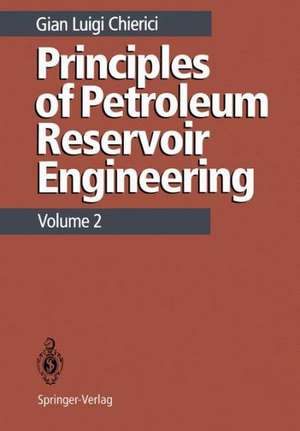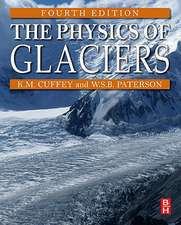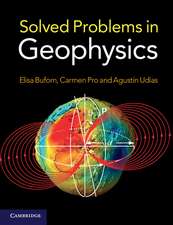Principles of Petroleum Reservoir Engineering: Volume 2
Autor Gian L. Chierici Traducere de P. J. Westawayen Limba Engleză Paperback – 30 dec 2011
| Toate formatele și edițiile | Preț | Express |
|---|---|---|
| Paperback (2) | 505.07 lei 38-44 zile | |
| Springer Berlin, Heidelberg – 30 dec 2011 | 505.07 lei 38-44 zile | |
| Springer Berlin, Heidelberg – 12 dec 2012 | 505.58 lei 38-44 zile |
Preț: 505.07 lei
Preț vechi: 623.54 lei
-19% Nou
Puncte Express: 758
Preț estimativ în valută:
96.64€ • 101.18$ • 79.97£
96.64€ • 101.18$ • 79.97£
Carte tipărită la comandă
Livrare economică 02-08 aprilie
Preluare comenzi: 021 569.72.76
Specificații
ISBN-13: 9783642782459
ISBN-10: 3642782450
Pagini: 428
Ilustrații: XXVI, 398 p.
Dimensiuni: 193 x 270 x 22 mm
Greutate: 0.89 kg
Ediția:Softcover reprint of the original 1st ed. 1995
Editura: Springer Berlin, Heidelberg
Colecția Springer
Locul publicării:Berlin, Heidelberg, Germany
ISBN-10: 3642782450
Pagini: 428
Ilustrații: XXVI, 398 p.
Dimensiuni: 193 x 270 x 22 mm
Greutate: 0.89 kg
Ediția:Softcover reprint of the original 1st ed. 1995
Editura: Springer Berlin, Heidelberg
Colecția Springer
Locul publicării:Berlin, Heidelberg, Germany
Public țintă
GraduateCuprins
11 Immiscible Displacement in Homogeneous Porous Media.- 11.1 Introduction.- 11.2 Basic Assumptions.- 11.3 Displacement in One-Dimensional Systems.- 11.3.1 The Fractional Flow Equation.- 11.3.2 The Buckley-Leverett Displacement Equation.- 11.3.2.1 Case 1 — Fractional Flow Curve fW(SW) Concave Downwards.- 11.3.2.2 Case 2 — Fractional Flow Curve fW(SW) Concave Upwards.- 11.3.2.3 Case 3 — Fractional Flow Curve fW(SW) S-Shaped.- 11.3.3 Calculation of the Average Saturation Behind the Front: Welge’s Equation.- 11.3.4 Calculation of Oil Recovery as a Function of Time, and the Fraction of Displacing Fluid in the Production Stream.- 11.3.5 The Effect of Oil Viscosity and Flow Rate on Displacement.- 11.3.6 Frontal Instability: Fingering.- 11.4 Displacement in a Two-Dimensional System (x, z).- 11.4.1 Segregated Flow — the Concept of Vertical Equilibrium (VE).- 11.4.2 Gravity Stabilisation of the Front in Segregated Flow.- 11.5 Relative Permeability and Capillary Pressure Pseudo-Curves.- 11.5.1 Total Layer Thickness ht Much Less Than the Height hc of the Capillary Transition Zone.- 11.5.2 Total Layer Thickness ht of the Same Order as the Height hc of the Capillary Transition Zone.- 11.5.3 Total Layer Thickness ht, Much Greater Than the Height hc of the Capillary Transition Zone.- References.- Exercises.- 11.1 Calculation of Sw,f and ER,o at water breakthrough for three different water/oil viscosity ratios, p. 41. — 11.2 Calculation of Sw,f, (fw)Bt and ED for the vertical displacement of oil by water, at three different frontal velocities, p. 44. — 11.3 Calculation of the critical velocity for the displacement of oil by gas, for five different sets of rock and fluid properties, p. 47. — 11.4 Calculation of the oil recovery factor for vertical displacement by gas,for five different velocities of the gas front, p. 48..- 12 The Injection of Water into the Reservoir.- 12.1 Introduction.- 12.2 The Development of Water Injection Technology.- 12.3 Factors Influencing Oil Recovery by Water Injection.- 12.4 ED: Microscopic Displacement Efficiency.- 12.5 Ev: Volumetric Efficiency.- 12.5.1 EA: Areal Sweep Efficiency.- 12.5.2 EI: Vertical Invasion Efficiency.- 12.5.2.1 Layers Not in Vertical Communication.- 12.5.2.2 Layers with Vertical Communication.- 12.6 Deformation of the Water/Oil Contact in the Near-Wellbore Region: “Water Coning”.- 12.6.1 Calculation of the Critical Flow Rate for Water Coning.- 12.6.2 Production Above the Critical Rate.- 12.7 Surveys and Tests in Reservoirs Produced Under Water Injection.- 12.7.1 Monitoring the Advance of the Water Front.- 12.7.2 Interwell Testing.- References.- Exercises.- 12.1 Calculation of fw as a function of ER,o, and ER,o(t) for the injection of water in a direct line drive pattern, p. 98. — 12.2 Calculation of the areal sweep efficiency EA(fw) for water injection in direct and staggered line drive patterns, at different values of Mwo. p. 101. — 12.3 Calculation of the pseudo-relative permeability curves for a multilayered reservoir, with vertical interlayer communication, p. 104. — 12.4 Program to calculate the pseudo-curves of relative permeability and capillary pressure in segregated and dispersed flow regimes for reservoirs consisting of several layers in vertical communication, p. 107. — 12.5 Calculation of the vertical invasion efficiency curve EI(fw) as a function of the fraction of water produced, for a reservoir consisting of several layers not in vertical communication, p. 114. — 12.6 Calculation of the critical oil flow rate for water coning for different penetrationratio and reservoir anisotropy, p. 118. — 12.7 Calculation of the time to water breakthrough, and the subsequent behaviour of fw in a well producing oil above the critical rate for water coning, p. 119..- 13 The Simulation of Reservoir Behaviour Using Numerical Modelling.- 13.1 Introduction.- 13.2 The Philosophy and Methodology Behind Numerical Modelling.- 13.3 Types of Numerical Model.- 13.3.1 Classification Based on the Way in Which the Flow Equations Are Discretised.- 13.3.2 Classification Based on Reservoir Geometry.- 13.3.3 Classification Based on the Number and Nature of the Mobile Phases.- 13.4 The Continuity Equation.- 13.5 The Flow Equation.- 13.6 Single Phase Flow of a Slightly Compressible Fluid.- 13.7 Single Phase Flow of Gas.- 13.8 Multiphase Flow.- 13.9 Generalised Compositional Equation for Multiphase Flow.- 13.10 Discussion of the Flow Equations.- 13.10.1 Monophasic Flow.- 13.10.2 Biphasic Flow.- 13.10.3 Triphasic Flow.- 13.11 Basic Principles of the Finite Difference Method.- 13.11.1 Discretisation.- 13.11.2 Types of Grid (or Mesh).- 13.11.3 Discretisation of Derivatives into Finite Differences.- 13.11.4 Choice of Time for the Spatial Derivative, and the Conditions for Stability.- 13.11.5 Rounding and Truncation Errors.- 13.12 Numerical Simulation of Single Phase Flow.- 13.12.1 The Finite Difference Equation for Single Phase Flow.- 13.12.2 Matrix Form of the Finite Difference Equation for Single Phase Flow.- 13.13 Solution of the Linear Algebraic Equations Derived from the Discretisation of the Flow Equation.- 13.13.1 Introduction.- 13.13.2 Direct Methods.- 13.13.2.1 The Gaussian Elimination Method.- 13.13.2.2 Triangular Matrices.- 13.13.2.3 Factorisation of the Coefficient Matrix.- 13.13.2.4 The Ordering of Sparse Matrices.- 13.13.3 IterativeProcedures.- 13.13.3.1 Introduction.- 13.13.3.2 The Point Jacobi Method (Simultaneous Displacement).- 13.13.3.3 The Point Gauss-Seidel Method (Successive Displacement).- 13.13.3.4 Point Successive Over-Relaxation (SOR).- 13.13.3.5 A Simple Example of the Use of Iterative Methods.- 13.13.4 Methods for Alternating Directions.- 13.13.4.1 Introduction.- 13.13.4.2 The ADI Method.- 13.13.4.3 The IADI Method.- 13.14 Numerical Simulation of Multiphase Flow.- 13.14.1 The Finite Difference Equation for Multiphase Flow.- 13.14.2 Numerical Dispersion and Its Treatment in Multiphase Flow.- 13.14.3 Solution of the Finite Difference Equation for Multiphase Flow.- 13.14.3.1 Choice of Solution Method.- 13.14.3.2 The IMPES Method.- 13.14.3.3 The Method of Simultaneous Solution.- 13.14.3.4 The Fully Implicit Method.- 13.15 Introduction to the Study of Reservoir Behaviour Through Numerical Modelling.- 13.16 Gathering, Editing and Preprocessing the Basic Data.- 13.16.1 Choice of Gridding for Reservoir Discretisation.- 13.16.2 Gross and Net Pay Thickness for Each Layer.- 13.16.3 Porosity and Pore Compressibility.- 13.16.4 Horizontal Permeability.- 13.16.5 Vertical Permeability.- 13.16.6 The Correlation Parameter.- 13.16.7 Capillary Pressure Curves.- 13.16.8 Relative Permeability Curves.- 13.16.9 PVT Properties.- 13.16.10 Initial Gas/Oil and Water/Oil Contacts.- 13.16.11 Initial Pressure and Temperature at the Reference Datum, and the Temperature Gradient.- 13.17 Initialisation of the Model.- 13.17.1 Calculation of Geometrical Parameters.- 13.17.2 Calculation of Phase Pressures.- 13.17.3 Calculation of Capillary Pressures and Saturations.- 13.17.4 Calculation of the Initial Volume of Fluids in the Reservoir.- 13.17.5 Plotting the Iso-Value Maps.- 13.18 Choice of Model and Method of Simulation.- 13.18.1 Choice of Model.- 13.18.2 Convergence and Stability Criteria.- 13.18.3 Simulation of the Displacement Process: Choice of Relative Permeability and Capillary Pressure Pseudo-Curves.- 13.19 Validation of the Numerical Model by Matching the Reservoir History.- 13.19.1 Scope and Methodology of the Validation Process.- 13.19.2 Data Needed for History Matching.- 13.19.3 Use of the Model in History Matching.- 13.19.4 Checking the History Match.- 13.20 Forecasting Reservoir Behaviour.- 13.20.1 Introduction.- 13.20.2 Production Constraints.- 13.20.2.1 Well Constraints.- 13.20.2.2 Surface Facility Constraints.- 13.20.2.3 Reservoir Constraints.- 13.20.3 Calculation of Well Flow Rates.- 13.20.3.1 Introduction.- 13.20.3.2 Wells Producing at Fixed Rates.- 13.20.3.3 Wells Producing at Deliverability.- 13.21 Summary.- References.- Exercises.- 13.1 Derivation of the continuity equation in radial coordinates, p. 213. — 13.2 Derivation of an expression for the coefficient a in Eq. (13.16b) for one- and two-dimensional geometries, p. 214. — 13.3 Derivation of equations to describe the behaviour of a reservoir containing a moderately volatile oil, and a black oil, from the generalised compositional equation (Eq. (13.41)] for polyphasic flow. p. 217. — 13.4 Derivation of Eq. (13.77), for the z-axis component of the transport term. p. 220. — 13.5 Derivation of the finite difference equations for three-dimensional polyphasic flow. p. 222. — 13.6 Expression of the general transport term in fully implicit form, eliminating non-linearity, p. 226..- 14 Forecasting Well and Reservoir Performance Through the Use of Decline Curves and Identified Models.- 14.1 Introduction.- 14.2 Production Decline Curves.- 14.2.1 Conditions for the Use of Decline Curves.- 14.2.2 TheCharacteristics of Decline Curves.- 14.2.3 Practical Applications of the Decline Curve Method.- 14.3 Identified Models.- 14.3.1 The Reservoir and Aquifer as a Single Dynamic System.- 14.3.2 The Basics of Systems Theory.- 14.3.2.1 Definitions.- 14.3.2.2 The “z-Transform”.- 14.3.3 Discrete Dynamic Systems.- 14.3.4 The Model Identification Procedure.- 14.3.4.1 Ordering of the Model.- 14.3.4.2 Determination of the Parameters of the Model.- 14.3.4.3 Evaluation of Model Stability.- 14.3.5 Practical Example: Identification of a Gas Reservoir with an Aquifer.- 14.3.5.1 Initial Considerations.- 14.3.5.2 The Minerbio Gas Reservoir.- 14.3.5.3 Determination of the Order of the Model.- 14.3.5.4 Investigation of the Conditions for Time Invariance.- 14.3.5.5 Validation of the Identified Model.- References.- Exercises.- 14.1 Use of decline curves to determine the incremental cumulative production at abandonment of a reservoir where infill wells have been drilled, p. 251..- 15 Techniques for Improving the Oil Recovery.- 15.1 Introduction.- 15.2 The Current Status of the World’s Oil Reserves.- 15.3 Quantity and Distribution of Oil Remaining in the Reservoir.- 15.3.1 Introduction.- 15.3.2 Methods for Evaluating the Overall Quantity of Remaining Oil.- 15.3.2.1 The Material Balance Method.- 15.3.2.2 Single Well Tracer Test.- 15.3.3 Determination of the Distribution of Remaining Oil Throughout the Reservoir.- 15.3.3.1 Retrieval and Analysis of Downhole Cores.- 15.3.3.2 Resistivity Logs.- 15.3.3.3 Pulsed Neutron Logs (PNL).- 15.3.3.4 Nuclear Magnetism Log (NML).- 15.4 ARM — Advanced Reservoir Management: Improvement of the Oil Recovery Factor by Optimisation of Water or Gas Injection.- 15.4.1 ARM for Water Injection.- 15.4.1.1 The Effect of Well-Spacing on Oil Recovery by WaterInjection.- 15.4.1.2 Why Infill Drilling Can Lead to an Increase in Oil Recovery.- 15.4.1.3 Optimising Infill Well Location by ARM Techniques.- 15.4.2 Crestal Injection of Non-Miscible Gas.- 15.4.2.1 Unidirectional Displacement of Oil by Gas in the Presence of Siw.- 15.4.2.2 Vertical Displacement of Oil by Gas in a Gravity-Stabilised Regime.- 15.4.2.3 Production of Oil Through Vertical Displacement by Gas Under Gravity-Dominated Conditions.- 15.5 Enhanced Oil Recovery (EOR): Definition and Classification of Methods.- 15.5.1 Introduction.- 15.5.2 Types of Enhanced Oil Recovery Methods.- 15.6 Steam Drive.- 15.6.1 The Influence of Temperature on Reservoir Rock and Fluid Properties.- 15.6.2 Steam Drive Technology.- 15.6.3 Problems Encountered in the Reservoir.- 15.6.4 Summary.- 15.7 Huff’n’puff, or Steam Soak.- 15.7.1 Origins of the Method.- 15.7.2 Steam Soak Technology.- 15.7.3 Reservoir Engineering Considerations.- 15.8 In Situ Combustion.- 15.8.1 Principles of the Method.- 15.8.2 What Happens in the Reservoir.- 15.8.3 Wet Combustion.- 15.8.4 Injection of Oxygen or Oxygen-Enriched Air.- 15.8.5 Summary.- 15.9 Miscible Gas Flooding.- 15.9.1 Introduction.- 15.9.2 Pseudo-Ternary Diagrams for the Reservoir Oil/Injection Gas Mixture.- 15.9.3 Phase Behaviour of a Mixture of Reservoir Oil/Gaseous Hydrocarbon and/or Nitrogen.- 15.9.3.1 Use of Pseudo-Ternary Diagrams to Describe Phase Behaviour..- 15.9.3.2 First Contact Miscibility.- 15.9.3.3 Multiple Contact Miscibility: Condensing Gas Drive.- 15.9.3.4 Multiple Contact Miscibility: Vaporising Gas Drive.- 15.9.4 Phase Behaviour of a Mixture of Reservoir Oil and Carbon Dioxide.- 15.9.4.1 Thermodynamic Properties of Carbon Dioxide.- 15.9.4.2 Type I Behaviour of a Mixture of Reservoir Oil and Carbon Dioxide.- 15.9.4.3 Type IIBehaviour of a Mixture of Reservoir Oil and Carbon Dioxide.- 15.9.5 Correlations for the Estimation of Minimum Miscibility Pressure (MMP).- 15.9.5.1 Vaporising Gas Drive.- 15.9.5.2 Condensing and Vaporising Gas Drives.- 15.9.5.3 Miscibility of Oil and Nitrogen.- 15.9.5.4 Miscible Displacement with Carbon Dioxide.- 15.9.6 Flow Regimes Encountered in Miscible Gas Drive.- 15.9.7 Displacement Under Gravity-Stabilised Conditions.- 15.9.8 Miscible Gas Drive Technology.- 15.9.9 Immiscible Flooding and Huff’n puff Using Carbon Dioxide.- 15.9.10 Summary.- 15.10 Polymer Flooding.- 15.10.1 Introduction.- 15.10.2 Polymers Used.- 15.10.3 Rheology of Polymer Solutions.- 15.10.3.1 Overview of Rheology.- 15.10.3.2 Polymer Solutions.- 15.10.4 Improvement of the Permeability Profile with Polymer Gels.- 15.10.5 Polymer Technology.- 15.10.6 Summary.- 15.11 Micellar/Polymer Flooding.- 15.11.1 Introduction.- 15.11.2 Water/Oil/Surfactant Micellar Solutions.- 15.11.3 Phase Behaviour of Water/Oil/Surfactant + Cosurfactant Systems.- 15.11.3.1 Type II(?) Systems.- 15.11.3.2 Type II(+) Systems.- 15.11.3.3 Type III Systems.- 15.11.4 The Effect of Water Salinity on the Properties of the System.- 15.11.5 Adsorption by the Reservoir Rock (Surfactant Retention).- 15.11.6 Micellar-Polymer Flooding Technology.- 15.11.7 Summary.- 15.12 Caustic Flooding.- 15.12.1 Introduction.- 15.12.2 The Interactions Behind the Process.- 15.12.3 Caustic Flooding Technology.- 15.12.4 Summary.- 15.13 Monitoring EOR Performance in the Reservoir.- 15.13.1 Classical Methods.- 15.13.2 Seismic Methods.- 15.13.2.1 Spatial Distribution of Fluid Saturations by 3D Seismic Surveys.- 15.13.2.2 Interwell Distribution of Fluid Saturations by Cross-Well Seismics.- 15.13.3 Electrical and Electromagnetic Methods.- 15.13.3.1 DCElectrical Techniques.- 15.13.3.2 Electromagnetic (EM) Methods.- 15.13.3.2.1 Controlled Source Audio Magnetic Tellurics (CSAMT).- 15.13.3.2.2 High-Frequency Electromagnetic (HFEM) Method.- 15.13.4 Summary.- 15.14 Selection of the Appropriate EOR Process for a Given Field.- 15.15 The Future of EOR.- References.- Exercises.- 15.1 Derivation of the equations relating oil recovery at breakthrough and Ngv, and the Corey n-exponent, for vertical non-miscible gas displacement, p. 369..- Author Index.
















